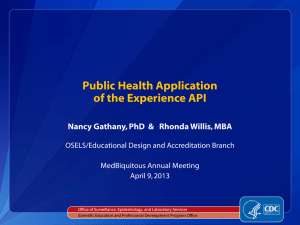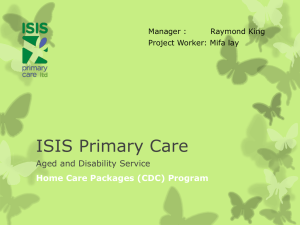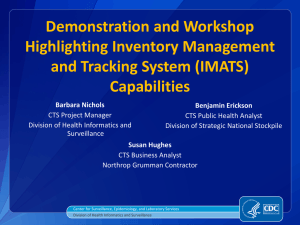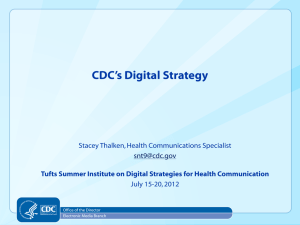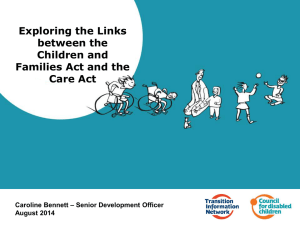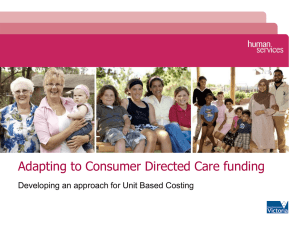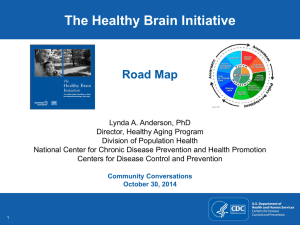Update on Pain Management Guidelines
advertisement
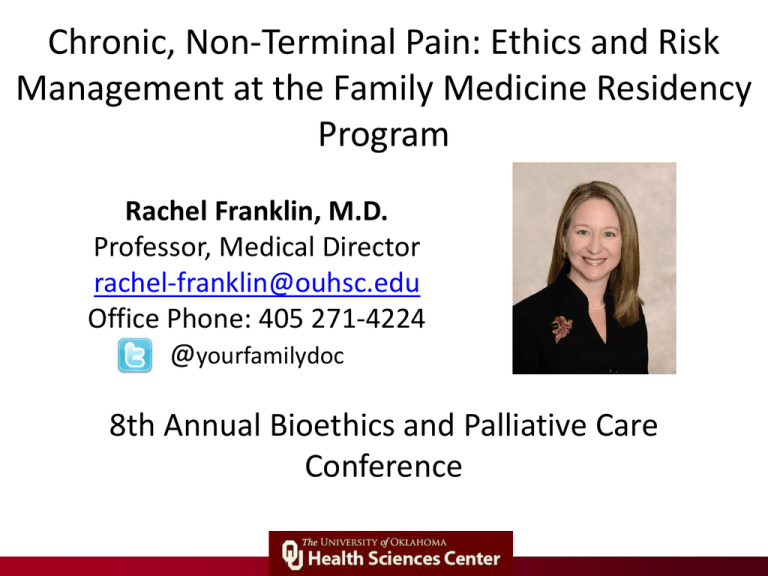
Chronic, Non-Terminal Pain: Ethics and Risk Management at the Family Medicine Residency Program Rachel Franklin, M.D. Professor, Medical Director rachel-franklin@ouhsc.edu Office Phone: 405 271-4224 @yourfamilydoc 8th Annual Bioethics and Palliative Care Conference Conflict of Interest Under Accreditation Council for Continuing Medical Education guidelines disclosure must be made regarding financial relationships with commercial interests within the last 12 months. Rachel Franklin, M.D. I have no financial relationships or affiliations to disclose. Learning Objectives Upon completion of this presentation, participants should be able to: 1. Identify the ethical and medico-legal issues related to the treatment of chronic, non-terminal pain. 2. Create a patient-centered and goal-directed chronic pain management regimen. 3. Organize the evaluation and management of patients with chronic pain, including follow up care. 4. Identify and manage barriers to effective pain control through integrated interprofessional care teams. The Clinical Challenge • NIH/IOM: effective pain management is – “Moral imperative” – “Professional responsibility” – “Duty of people in the healing professions” • Pain versus “suffering” • LITTLE good evidence; plus… – – – – Plenty of pain “procedurists” Few pain “management” specialists Poor training of primary care providers Poor access to multidisciplinary care of “suffering” Source: Relieving Pain in America: A Blueprint for Transforming Prevention, Care, Education and Research. The National Academies Press, 2011. Background: The Burden of Pain 100 Million Americans 75 50 25 0 Chronic Pain Diabetes Coronary Heart Disease Stroke Cancer Chronic Health Condition Sources: Institute of Medicine Report from the Committee on Advancing Pain Research, Care, and Education: Relieving Pain in America, A Blueprint for Transforming Prevention, Care, Education and Research. The National Academies Press, 2011. http://books.nap.edu/openbook.php?record_id=13172&page=1. American Diabetes Association http://www.diabetes.org/diabetes-basics/diabetes-statistics/ Heart Disease and Stroke Statistics—2011 Update: A Report From the American Heart Association. Circulation 2011, 123:e18-e209, page 20. http://circ.ahajournals.org/content/123/4/e18.full.pdf American Cancer Society, Prevalence of Cancer http://www.cancer.org/docroot/CRI/content/CRI_2_6x_Cancer_Prevalence_How_Many_People_Have_Cancer.asp Background: The Spectrum of Pain • Disability – Low Back Pain leading cause in <45 y/o – 26M in U.S. 20-64y/o report frequent LBP • Lost productivity – “In past 2 weeks:” 12.7% lost production time – Workers lose 4.6 hrs/wk due to pain – $61.2B due to lost production time – 76.6% due to reduced work performance Sources: National Centers for Health Statistics, Chartbook on Trends in the Health of Americans 2006, Special Feature: Pain. http://www.cdc.gov/nchs/data/hus/hus06.pdf. Accessed 11/20/13 and Results from the American Productivity Audit. http://www.ncbi.nlm.nih.gov/pubmed/14665809 Accessed 11/20/13 Background: The Costs of Pain • Pain changes life trajectory – – – – 20% took disability 17% change jobs 13% require help with ADLs 13% moved to new home • Patients seek relief – – – – 63% saw Family Doctor (that’s ~63 million people) 40% saw specialist 25% saw chiro 38% saw more than one provider Source: Peter D. Hart Research Associates. Page 3. KEY FINDINGS. Americans in Pain. Much of America is hurting: http://www.researchamerica.org/uploads/poll2003pain.pdf Accessed 11/20/13 Top Five Prescription Drugs Sold in U.S. Prescribing: Out of Control? Source: CDC http://www.cdc.gov/vitalsigns/opioid-prescribing/infographic.html Prescribing: Out of Control? Source: CDC http://www.cdc.gov/vitalsigns/opioid-prescribing/infographic.html Drug Overdose Deaths Compared to Other Accidents Sources: “Prescription Painkiller Overdoses in the US.” CDC Vital Signs, November 2011 http://www.cdc.gov/vitalsigns/PainkillerOverdoses/; Opioid Overdose Deaths Compared to Other Drugs Sources: “Prescription Painkiller Overdoses in the US.” CDC Vital Signs, November 2011 http://www.cdc.gov/vitalsigns/PainkillerOverdoses/; Pregnancy and Neonatal Period • 55-94% of exposed neonates will develop NAS • Maternal detox increases fetal distress/fetal loss • Methadone worse than heroin Sources: Neonatal Abstinence Syndrome and Associated Health Care Expenditures, United States 2000-2009. JAMA. 2012;307(18):1934-1940. doi:10.1001/jama.2012.3951 accessed online at http://jama.jamanetwork.com/article.aspx?articleid=1151530 November 20, 2013 Hudak, ML and Tan, R. Neonatal Drug Withdrawal. Pediatrics 2012; 129;e540 www.pediatrics.aappublications.org Accessed from Bird Library 2/28/13 Pregnancy and Neonatal Period • 2000-2009: neonatal abstinence syndrome (NAS) triples • 2009 - 3.4:1,000 • Length of stay: 1 week-2 months • Hospital Charges average $53,400 (77.6% Medicaid) • Risks – – – – Respiratory distress syndrome (30.9% vs. 8.9%) Low birth weight (19.1% vs. 7.0%) Feeding difficulty (18.1% vs. 2.8%) Seizure (2.3% vs. 0.1%) Source: Neonatal Abstinence Syndrome and Associated Health Care Expenditures, United States 2000-2009. JAMA. 2012;307(18):1934-1940. doi:10.1001/jama.2012.3951 accessed online at http://jama.jamanetwork.com/article.aspx?articleid=1151530 November 20, 2013 Nonmedical Use of Painkillers • 7 million Americans (2.7%) • 1 in 12 Oklahomans (#1 in nation) • High school seniors: – 1:12 Vicodin – 1:20 OxyContin – 70% obtained from family or friend Sources: “Prescription Painkiller Overdoses in the US.” CDC Vital Signs, November 2011 http://www.cdc.gov/vitalsigns/PainkillerOverdoses/; Fact Sheet on Prescription Drug Abuse, Misuse and Consequences Among Oklahoma (sic). Oklahoma Department of Mental Health and Substance Abuse Services. http://ok.gov/odmhsas/documents/PR%20RxAbuse-FactSheet.pdf ; Oklahoma is OK? • #1: illicit use of prescription pain meds (all age categories) • #9: overdoses due to prescription pain meds • Top ten: Kilos of prescription painkillers per 10,000 • Top five: prescriptions painkillers per person (1.28) Sources: “Prescription Painkiller Overdoses in the US.” CDC Vital Signs, November 2011 http://www.cdc.gov/vitalsigns/PainkillerOverdoses/; Fact Sheet on Prescription Drug Abuse, Misuse and Consequences Among Oklahoma (sic). Oklahoma Department of Mental Health and Substance Abuse Services. http://ok.gov/odmhsas/documents/PR%20RxAbuse-FactSheet.pdf ; Automation of Reports and Consolidated Orders System (ARCOS) of the Drug Enforcement Administration (DEA), 2010 The Challenges – Patient Factors • Sociocultural – Blacks: bias prevents adequate treatment – Whites: more likely to OD – Youth: highest OD risk age 26-35 • Noncompliance – Non-opiate: approaches 90% – Opiate: over, rather than underuse • Failure to disclose – Alcohol – Illicit drugs The Challenges – Patient Factors • Unrealistic expectations – Opioids always = pain relief – More opioids = more relief – “I need more pain medicine” • Potential for harm: – – – – – Overdose Loss of function Hyperalgesia Hypogonadism Osteoporosis Sources: REMS strategy for rational pain control. www.scopeofpain.com The Challenges – System Factors • Time limitations • Patient expectations/satisfaction drive compensation • Provider – – – – Lack of education Wrong focus: pain versus function Lack of oversight/patient education Bias • Process – Staff education – Clinical guidelines – Patient flow management The Challenges – Results • Undertreatment • Wrong treatment – Underutilization of non-pharmacologic therapies – Overutilization of opiates rather than non-opiates – De-emphasis of patient autonomy/responsibility • Accidental death – 2012: 534 in Oklahoma – Half took meds prescribed by their own doctors The Challenges – Results The Charge • Develop standardized, evidence-based curriculum for evaluation of chronic pain • Create clinical environment within which to deliver curricular care to patients • Vision: OB intake/followup • Resources: LEAN/Six Sigma team, faculty, residents and staff Source: Charge to the Chronic Pain Curriculum Committee, Steven Crawford, M.D. Committee Members: Rachel Franklin, M.D. – committee chair Kalyanakrishnan Ramakrishnan, M.D. Audra Fox, M.D. Bryan Billings, M.D. Chris Shadid, M.D. Reuben Walia, M.D. Annette Prince, J.D., LCSW Cynthia Thomas, MSW, LCSW Sherrie Moser, patient advocate Ex-Officio: Steven Crawford, M.D. and James Barrett, M.D. Findings: Fundamentals • Patient as the center of care – – – – Include patient in care plan Assess understanding of condition Educate regarding illness at every visit Overall goal: empower patient, set realistic expectations • Quantify pain – Written instruments are essential – History must be standardized – Watch for pain “generators” – other factors that influence pain experience Fundamentals • Identify yellow/red flags early – Red flags: potentially serious cause present • Cancer • Infection • Autoimmune disease – Yellow flags: adverse prognostic indicators • Age • Unemployment/disability/work comp/litigation • Severity of presenting symptoms compared with findings Fundamentals • Treatment is a negotiation – – – – – Goal: relief sufficient to improve function Mechanism-based treatment plan Multimodal non-opiate therapy is first Complementary therapies must be used as appropriate Opiate treatment is a trial of therapy (communicate!) • Opiates not appropriate for every patient! • Focus on function, not pain – Physical function – Effect on biopsychosocial factors Fundamentals • Account for culture/gender differences – AA have more trouble accessing care – AAF>CF to present with “severe” pain – Whites more likely to OD – Nonverbal cues can mislead • Symptom magnification • Symptom denial – Identify/reduce miscommunication and bias Fundamentals: The Treatment Plan • Individualized – Understand mechanism – Understand patient risk profile – Understand/negotiate patient goals • Pain tolerability – NOT “pain free” • Improved physical/psychosocial function – Realistic expectations • Patient responsibilities – PT, others • Physician options/limitations Fundamentals: The Treatment Plan • Measurable – Pain disability index – Quality of life/functional performance scores • Monitored – set follow up goals – More studies? – Non-opioid treatments? – Other modalities? • • • • Trigger point injection PT Osteopathic manipulation Interventional therapies/surgery • Opioids are a “trial” Fundamentals: Emphasis • Objectivity – Measure function rather than pain level – Display function over time to patient • Balance risk:benefit – Patient risk level – Risk of medicine/adverse effects • Target likely mechanism EMR Templates Conduct of the Visit/Presentation • • • • History Prior studies/results Prior treatment/results Patient perception of pain – What’s causing it? – What bothers them most about it? – What do they fear about it? – What are their goals? Conduct of the Visit/Presentation • Patient’s goals for care – Identify expectations – Prepare for, but don’t start, negotiation • Mental health evaluation – History of mental illness – Any psychotropic meds/anxiolytics? • Biopsychosocial evaluation – Limitations on access to care/compliance – Stressors – Family support Conduct of the Visit/Presentation • Physical examination – General health – Comprehensive exam of affected area • • • • Neurologic Musculoskeletal Vascular Other as indicated (trigger points?) • Review of available studies – Are more needed? – Is referral needed for diagnostic evaluation? Conduct of the Visit/Presentation • Determine pain etiology – – – – Inflammatory: RA, OA, SLE Neuropathic: neuropathies, radiculopathies, CVA/MS Mixed Functional • Determine nature of maladaptive pain – Peripheral sensitization – Central sensitization • Determine biopsychosocial comorbidities – is multidisciplinary care needed/available? Risk Factor Assessment • Based on patient completed self-assessment – Opiate Risk Tool – CAGE-AID questionnaire • Adjustable based on prior knowledge • Scores place patient in risk category – Low – appropriate for our practice – Intermediate – appropriate with additional support – High – refer to pain management Risk Stratification • Anxiolytics • High risk medicines – Methadone – Suboxone – High dose opioids The Agreement • Required for all FMC patients on chronic opioid therapy • Informed consent document – Risks/benefits of medicine – When to notify provider – Mutual responsibilities • Must be renewed with new provider Urine Drug Screening • Required for intermediate risk patients – At first prescription – Randomly: up to 2 times per year – At suspicion of trouble – team lead nurse authorized to order (standing orders) • Is it covered? – Yes – Best diagnosis: V58.69 (long-term [current] use of other medication) – Caveat: new Medicaid guidelines Urine Drug Screening • Standard screen (~$50) – Reliable for morphine, codeine, heroin, drugs of abuse – Unable to detect oxy/hydrocodone, methadone, fentanyl, buprenorphine, tramadol – Do not use for therapeutic monitoring • Comprehensive screen – Not done at point of care – 4 times the cost ~($200) – May limit access to care for uninsured patients Urine Drug Screening • Use screen to: – Confirm treatment compliance – Confirm absence of illicit/non-prescribed drugs – Reinforce risk/benefit discussion with patient Source: Standridge J, Adams A and Zotos A. Urine Drug Screening: A Valuable Office Procedure. Am Fam Physician 2010 Mar 1;81(5):635-640 http://www.aafp.org/afp/2010/0301/p635.html Accessed 1/18/13 Urine Drug Screening – Unexpected Results • GC/MS MS • Med review is mandatory – before UDS done • False positives - examples – Amphetamine: SSRI, decongestants, promethazine – Benzodiazepine: sertraline – Opiates: dextromethorphan, diphenhydramine, fluoroquinolones, verapamil – THC: NSAIDs, pantoprazole (Protonix) Follow Up • Low risk: 3-4 months or with routine comorbid conditions – OBNDD report review – UDS if indicated • Intermediate risk: monthly or more often, then individualized – OBNDD report review – UDS routinely and as indicated – Consider pill counts Workflows • Refills – OBNDD review, last and next visit, compliance – Attending checks prior to authorizing • Office visits – – – – Scheduling “hot words” 2 day chart check: OBNDD, EMR templates Check in: EMR template, nurse reviews last dose Check out: confirm agreement, flag in EMR Discussing Continued Lack of Benefit • • • • • Empathize, empathize, empathize Express your frustration Focus on patient’s strengths Encourage coping strategies Commit to continued care for patient and pain, even without opioids • Schedule close follow ups Source: REMS strategy for rational pain control. www.scopeofpain.com Phase 2 • Hiring second LCSW/LADC for clinic integration – Goals – Reimbursement • Pfizer grant: if awarded – Support second LCSW/LADC beyond initial grant – Add RN patient navigator • Disseminate best practices Conclusion and Clinical Pearls • Effective treatment of chronic pain is our duty • Opiate misuse/abuse is a deadly epidemic • Treatment goal: improved function despite pain • Standardizing clinic process improves care – Standardized histories, status assessments – PMP reports, UDS, contracts • Not all treatment failure is patient’s “fault” • Not all pain can be managed in primary care


